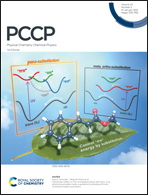Metallic and anti-metallic properties of hydrogen adsorbed AnO2 (An = Th, U, and Pu) surfaces†
Abstract
The effect of atomic hydrogen adsorption on AnO2 (An = Th, U, and Pu) surfaces is studied in the framework of density functional theory and Hubbard-corrected density functional theory. Several adsorption coverages (1/3, 1/2, 2/3, and 1 monolayer) are considered. For the band insulator ThO2, surface metallicity induced by hydrogen adsorption is observed due to the electron donation of the hydrogen to the surface. But this effect is found to be strongly suppressed by electronic correlation for the Mott insulators UO2 and PuO2 because the electrons from the adsorbed hydrogen atoms occupy the localized 5f orbitals of the surface U/Pu atoms.



 Please wait while we load your content...
Please wait while we load your content...